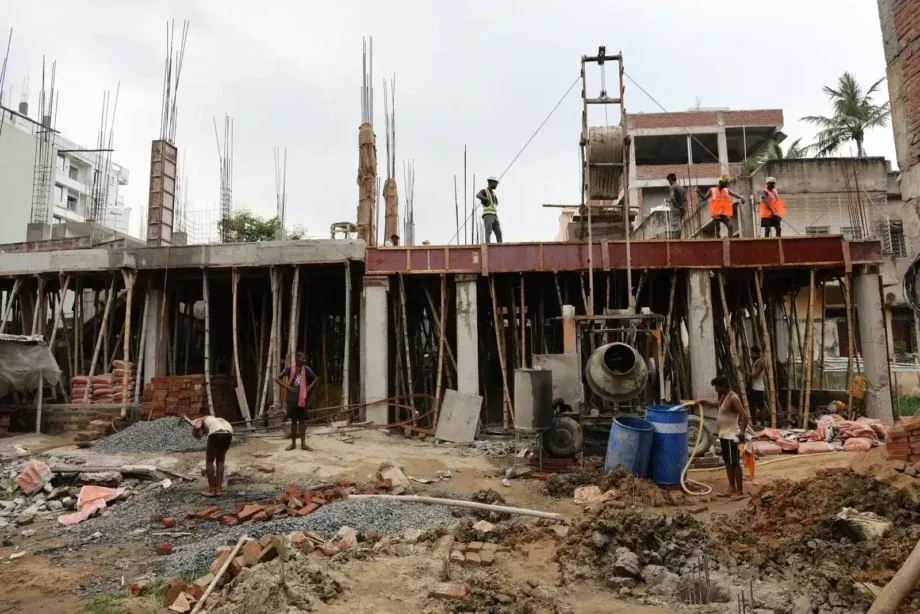The nature of construction is often misunderstood or misinterpreted. To many it may seem like a single, unified field. But it actually branches into multiple categories. Each of them is governed by distinct rules, materials, and processes.
Two categories dominate the construction landscape – residential construction and commercial construction. It’s important for all stakeholders involved to know the difference between residential and commercial construction.
WHAT ARE THE KEY DIFFERENCES?
The following details the key differences.
DIFFERENCE 1: PURPOSE, FUNCTION, & END-USER NEEDS
The structure’s purpose is a key differentiator. Residential construction’s purpose is to create living spaces.
Like,
- Single-family homes.
- Apartments and condominiums.
- Duplexes. Or townhouses.
- Villas and private residences.
The whole approach is to
- Create personal spaces where families can thrive.
- Provide safety and liveability.
Design choices are influenced by lifestyle requirements and personal preferences.
COMMERCIAL CONSTRUCTION
Commercial buildings cater to business or public functions.
These include:
- Retail stores and malls.
- Hotels and restaurants.
- Office buildings.
- Hospitals. Also, clinics.
- Industrial facilities. Also, warehouse facilities.
These spaces must efficiently support
- Operations;
- Foot traffic;
- Workflows;
- Logistics; and
- Safety standards.
The construction design revolves around:
- Accessibility;
- Productivity; and
- Compliance.
DIFFERENCE 2: ARCHITECTURAL DESIGN & TECHNCIAL COMPLEXITY
Architectural complexity is a major point of distinction.
Residential construction tends to:
- Follow simple repeatable layouts.
- Include moderate structural demands.
- Prioritize interior aesthetics.
- Use smaller floor areas.
Custom homes can be intricate. Most residential constructions however rely on standard construction patterns. They maximize cost-efficiency.
COMMERCIAL CONSTRUCTION
Constructions are technically and Structurally complex.
They can require:
- Large open floor plates.
- Multiple exits and fire safety systems.
- Advanced HVAC. Also, ventilation.
- Elevators and escalators.
- Heavy-duty materials. Also, reinforcements.
- Loading bays and storage zones.
Commercial architects must consider
- Zoning laws.
- Industry-specific space requirements.
- Business-grade durability.
DIFFERENCE 3: BUILDING CODES, PERMITS, & REGULATORY COMPLIANCE
Regulation intensity is among the core key differences.
Residential construction focuses on:
- Family safety.
- Proper insulation. Also, ventilation.
- Electrical standards. Also, plumbing standards.
- Structural integrity for low-rise buildings.
The scope of work and risks are limited. This makes permit approvals relatively faster.
COMMERCIAL CONSTRUCTION
They should conform to more stringent regulations.
Like,
- Accessibility standards. Like ADA Compliance.
- Parking and zoning rules.
- Fire safety laws. Like sprinklers, detectors, evacuation paths.
- Energy efficiency requirements.
- Environmental impact assessments.
- Public-use safety standards.
The overall approval process can be lengthy. Besides, regular inspections are throughout the project lifecycle mandatory.
DIFFERENCE 4: MATERIALS USED & STRUCTURAL STRENGTH
Material selection differs considerably.
KEY DIFFERENCES
Residential Construction involves the use of:
- Wood framing;
- Lightweight roofing;
- Foam insulation;
- Standard bricks or concrete blocks; and
- Domestic plumbing and wiring systems.
These materials work well for controlled occupancy levels. They also work well for smaller structures.
COMMERCIAL CONSTRUCTION
Commercial construction involves the use of:
- High-capacity HVAC units;
- Industrial grade electrical systems;
- Heavy-roofing and advanced insulation;
- Durable flooring with the capability to handle heavy loads;
- Steel frameworks. Or reinforced concrete; and
- Fire-resistant materials.
These materials offer stability and longevity. They also ensure compliance under high usage.
DIFFERENCE 5: PROJECT SCALE, DURATION, & PHASING
Most residential constructions are small in size.
A typical home:
- Takes 4 to 12 months to complete.
- Requires fewer subcontractors.
- Have simpler project scheduling.
Even large residential societies adhere to predictable timelines.
COMMERCIAL CONSTRUCTION
They involve multiple stakeholders. Additionally, they are also more complex.
As such they require:
- Longer timelines;
- Specialized labor;
- Heavy equipment;
- Multiple phases. This includes design, permitting, construction, and testing; and
- Additional documentation and inspections.
A commercial building can consume 1-2 years to complete. This depends on the building’s size and regulatory requirements.
DIFFERENCE 6: COST, BUDGETING, & FINANCIAL PLANNING
Budget considerations form a major part of construction process.
Residential constructions are smaller. This is due to:
- Limited square footage;
- Simpler material use; and
- Lower structural demands.
Homeowners often have fixed budgets. They also have financing options like home loans.
COMMERCIAL CONSTRUCTION
Commercial constructions are more complex in scope and scale.
Budgets for commercial projects are significantly larger. Costs can escalate due to:
- High-end materials;
- Safety systems;
- Specialized labor;
- Design sophistication;
- Heavy machinery equipment; and
- Government compliance processes.
Budgets can run into millions of rupees. Financing options often involves investors, lending bodies, or corporations.
DIFFERENCE 7: WORKFORCE EXPERTISE & SPECIALIZATION
Residential constructions employ:
- Carpenters;
- General electricians;
- Interior designers;
- Masons;
- Plumbers; and
- Painters.
There is more focus on home-scale systems.
COMMERCIAL CONSTRUCTION
They require highly specialized professionals.
Like,
- Commercial-grade plumbers;
- Elevator technicians;
- Mechanical installation teams;
- Fire safety consultants;
- Industrial electricians;
- Structural engineers; and
- Project managers and compliance officers.
The skills required for commercial constructions are often more sophisticated and advanced. This is due to the scale and technical needs.
DIFFERENCE 8: SAFETY PROTOCOLS & RISK MANAGEMENT
Safety standards are highly important.
Commercial sites compared to residential sites need more a rigorous approach.
In residential constructions, risks are relatively lower. Safety measures taken include;
- Basic safety gear.
- Standard electrical and structural practices.
- Limited heavy machinery.
COMMERCIAL CONSTRUCTION
Commercial sites involve:
- High-rise construction risks.
- Heavy machinery operations.
Safety measures taken include:
- Strict safety audits.
- Large manpower coordination.
- Emergency preparedness plans.
Safety documentation and inspections are at every stage essential.
DIFFERENCE 9: PROJECT MANAGEMENT SYSTEMS
Professional management is in Commercial VS Residential Construction, another major differentiator.
Project management in residential construction is handled by:
- General contractor.
- Small team of subcontractors.
- Occasional architectural oversight.
Documentation is minimal.
COMMERCIAL CONSTRUCTION
More emphasis is placed on:
- Multi-stage planning.
- Detailed documentation and reporting.
- Software-driven project management.
The whole process involves:
- Multiple subcontractors.
- Regular Government inspections.
Coordination is more complex. They require continual oversight. This helps to prevent or avoid delays and compliance issues.
DIFFERENCE 10: CUSTOMIZATION & FLEXIBILITY
Homeowners often customize:
- Layout changes.
- Interiors.
- Paints, finishes, and décor.
- Landscaping.
Personal modification is given more priority in residential construction.
COMMERCIALCONSTRUCTION
Customization in commercial constructions is driven by:
- Industry norms.
- Functionality.
- Branding. In hospitality or retail.
- Compliance constraints.
Flexibility is lower in commercial constructions. That’s because the structures need to support standardized operational flows.
CONCLUSION
So, what are the key differences between Residential and Commercial Construction? Both demand safe, functional structures. But they operate under totally different requirements.
This includes materials, skill-sets, regulations, and timelines.
Residential construction gives priority to:
- Aesthetics;
- Personal comfort; and
- Affordability.
Commercial construction on other hand requires:
- Advanced engineering;
- Stringent compliance;
- Durability; and
- Precision.
Enlisting the expertise of leading building contractor like Thikedaar will help you make informed decisions. You will benefit from specialist knowhow and also benefit from understanding what each construction involves. They finally ensure smoother project execution.



